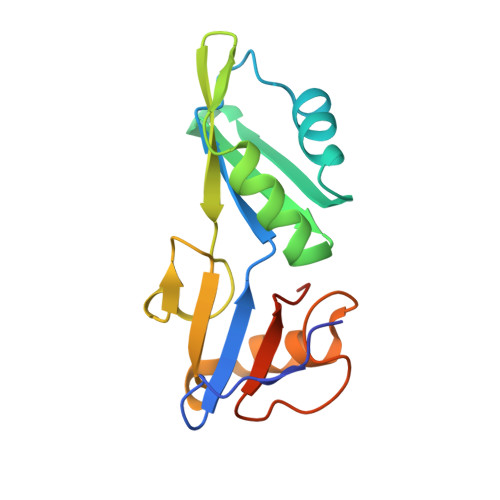Genetic screen for suppression of transcriptional interference identifies a gain-of-function mutation in Pol2 termination factor Seb1.
Schwer, B., Garg, A., Jacewicz, A., Shuman, S.(2021) Proc Natl Acad Sci U S A 118
- PubMed: 34389684
- DOI: https://doi.org/10.1073/pnas.2108105118
- Primary Citation of Related Structures:
7MI2 - PubMed Abstract:
The system of long noncoding RNA (lncRNA)-mediated transcriptional interference that represses fission yeast phosphate homoeostasis gene pho1 provides a sensitive readout of genetic influences on cotranscriptional 3'-processing and termination and a tool for discovery of regulators of this phase of the Pol2 transcription cycle. Here, we conducted a genetic screen for relief of transcriptional interference that unveiled a mechanism by which Pol2 termination is enhanced via a gain-of-function mutation, G476S, in the RNA-binding domain of an essential termination factor, Seb1. The genetic and physical evidence for gain-of-function is compelling: 1) seb1-G476S de-represses pho1 and tgp1 , both of which are subject to lncRNA-mediated transcriptional interference; 2) seb1-G476S elicits precocious lncRNA transcription termination in response to lncRNA 5'-proximal poly(A) signals; 3) seb1-G476S derepression of pho1 is effaced by loss-of-function mutations in cleavage and polyadenylation factor (CPF) subunits and termination factor Rhn1; 4) synthetic lethality of seb1-G476S with pho1 derepressive mutants rpb1-CTD-S7A and aps1 ∆ is rescued by CPF/Rhn1 loss-of-function alleles; and 5) seb1-G476S elicits an upstream shift in poly(A) site preference in several messenger RNA genes. A crystal structure of the Seb1-G476S RNA-binding domain indicates potential for gain of contacts from Ser476 to RNA nucleobases. To our knowledge, this is a unique instance of a gain-of-function phenotype in a eukaryal transcription termination protein.
- Department of Microbiology and Immunology, Weill Cornell Medical College, New York, NY 10065; s-shuman@ski.mskcc.org bschwer@med.cornell.edu.
Organizational Affiliation:


















